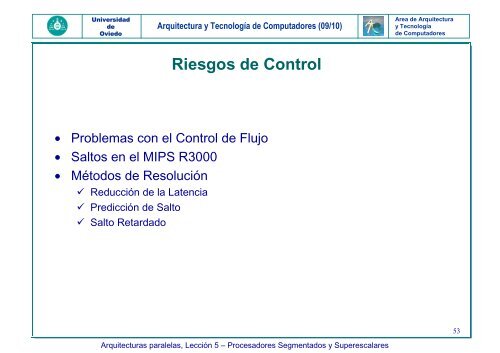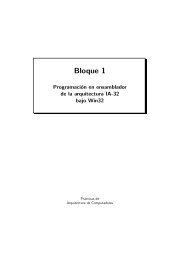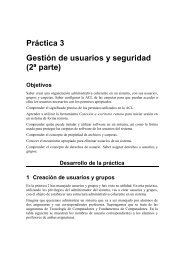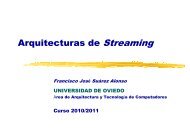Salto Retardado - Arquitectura y Tecnología de Computadores ...
Salto Retardado - Arquitectura y Tecnología de Computadores ...
Salto Retardado - Arquitectura y Tecnología de Computadores ...
Create successful ePaper yourself
Turn your PDF publications into a flip-book with our unique Google optimized e-Paper software.
Universidad<br />
<strong>de</strong><br />
Oviedo<br />
<strong>Arquitectura</strong> y <strong>Tecnología</strong> <strong>de</strong> <strong>Computadores</strong> (09/10)<br />
Riesgos <strong>de</strong> Control<br />
• Problemas con el Control <strong>de</strong> Flujo<br />
• <strong>Salto</strong>s en el MIPS R3000<br />
• Métodos <strong>de</strong> Resolución<br />
� Reducción <strong>de</strong> la Latencia<br />
� Predicción <strong>de</strong> <strong>Salto</strong><br />
� <strong>Salto</strong> <strong>Retardado</strong><br />
<strong>Arquitectura</strong>s paralelas, Lección 5 – Procesadores Segmentados y Superescalares<br />
Area <strong>de</strong> <strong>Arquitectura</strong><br />
y <strong>Tecnología</strong><br />
<strong>de</strong> <strong>Computadores</strong><br />
53
Universidad<br />
<strong>de</strong><br />
Oviedo<br />
<strong>Arquitectura</strong> y <strong>Tecnología</strong> <strong>de</strong> <strong>Computadores</strong> (09/10)<br />
Problemas con el Control <strong>de</strong> Flujo<br />
<strong>Arquitectura</strong>s paralelas, Lección 5 – Procesadores Segmentados y Superescalares<br />
Area <strong>de</strong> <strong>Arquitectura</strong><br />
y <strong>Tecnología</strong><br />
<strong>de</strong> <strong>Computadores</strong><br />
• Provocados por las rupturas en la ejecución secuencial <strong>de</strong> los<br />
programas:<br />
�<br />
�<br />
• Se traducen en una in<strong>de</strong>terminación a la hora <strong>de</strong> emitir las<br />
siguientes Instrucciones a ejecutar mientras no se conoce el<br />
nuevo punto <strong>de</strong> ejecución (el resultado <strong>de</strong>l salto)<br />
54
i<br />
i+1<br />
i+2<br />
Universidad<br />
<strong>de</strong><br />
Oviedo<br />
BUS D/L ALU<br />
BUS D/L ALU<br />
<strong>Arquitectura</strong> y <strong>Tecnología</strong> <strong>de</strong> <strong>Computadores</strong> (09/10)<br />
<strong>Salto</strong>s en el MIPS R3000<br />
Comparación<br />
<strong>Salto</strong><br />
� La dirección efectiva <strong>de</strong>l salto no se conoce hasta <strong>de</strong>spués <strong>de</strong> dos ciclos<br />
(<br />
<strong>Arquitectura</strong>s paralelas, Lección 5 – Procesadores Segmentados y Superescalares<br />
}<br />
Area <strong>de</strong> <strong>Arquitectura</strong><br />
y <strong>Tecnología</strong><br />
<strong>de</strong> <strong>Computadores</strong><br />
� Las instrucciones <strong>de</strong> salto representan entre el 15 y el 30% <strong>de</strong>l total <strong>de</strong> instrucciones<br />
55
Universidad<br />
<strong>de</strong><br />
Oviedo<br />
DLX<br />
8086<br />
VAX<br />
<strong>Arquitectura</strong> y <strong>Tecnología</strong> <strong>de</strong> <strong>Computadores</strong> (09/10)<br />
Instrucciones <strong>de</strong> Control<br />
2%<br />
Frecuencia <strong>de</strong> instrucciones <strong>de</strong> control en varias arquitecturas<br />
(53% <strong>de</strong> saltos condicionales efectivos en DLX)<br />
7%<br />
8%<br />
<strong>Arquitectura</strong>s paralelas, Lección 5 – Procesadores Segmentados y Superescalares<br />
11%<br />
14%<br />
17%<br />
Incondicionales<br />
Condicionales<br />
Area <strong>de</strong> <strong>Arquitectura</strong><br />
y <strong>Tecnología</strong><br />
<strong>de</strong> <strong>Computadores</strong><br />
56
Universidad<br />
<strong>de</strong><br />
Oviedo<br />
TeX<br />
Spice<br />
GCC<br />
<strong>Arquitectura</strong> y <strong>Tecnología</strong> <strong>de</strong> <strong>Computadores</strong> (09/10)<br />
Retardos <strong>de</strong> <strong>Salto</strong><br />
4%<br />
4%<br />
3%<br />
4%<br />
4%<br />
Porcentaje <strong>de</strong> los ciclos <strong>de</strong> reloj en los retardos (<strong>de</strong> carga y salto)<br />
frente a los consumidos por ejecución <strong>de</strong> Instrucciones<br />
<strong>Arquitectura</strong>s paralelas, Lección 5 – Procesadores Segmentados y Superescalares<br />
11%<br />
<strong>Salto</strong><br />
Carga<br />
Area <strong>de</strong> <strong>Arquitectura</strong><br />
y <strong>Tecnología</strong><br />
<strong>de</strong> <strong>Computadores</strong><br />
57
Universidad<br />
<strong>de</strong><br />
Oviedo<br />
• Parada <strong>de</strong>l cauce (<br />
• Reducción <strong>de</strong> la Latencia<br />
<strong>Arquitectura</strong> y <strong>Tecnología</strong> <strong>de</strong> <strong>Computadores</strong> (09/10)<br />
Métodos <strong>de</strong> Resolución<br />
<strong>Arquitectura</strong>s paralelas, Lección 5 – Procesadores Segmentados y Superescalares<br />
Area <strong>de</strong> <strong>Arquitectura</strong><br />
y <strong>Tecnología</strong><br />
<strong>de</strong> <strong>Computadores</strong><br />
� Anticipar las operaciones que se puedan <strong>de</strong>ntro <strong>de</strong>l proceso <strong>de</strong> ejecución <strong>de</strong><br />
las instrucciones <strong>de</strong> salto<br />
• Efectuar la búsqueda <strong>de</strong> Instrucciones por las dos ramas<br />
� Ahorro <strong>de</strong>l ciclo <strong>de</strong> búsqueda <strong>de</strong> instrucción una vez resuelto el salto<br />
• Predicción <strong>de</strong> <strong>Salto</strong><br />
� Estática<br />
� Dinámica<br />
• <strong>Salto</strong> <strong>Retardado</strong><br />
� Hacer visible la latencia al nivel <strong>de</strong> lenguaje máquina<br />
(<br />
58
Universidad<br />
<strong>de</strong><br />
Oviedo<br />
<strong>Arquitectura</strong> y <strong>Tecnología</strong> <strong>de</strong> <strong>Computadores</strong> (09/10)<br />
• Averiguar antes si el salto es o no efectivo<br />
• Calcular antes la dirección <strong>de</strong> <strong>de</strong>stino <strong>de</strong>l salto<br />
Ejemplo:<br />
Reducción <strong>de</strong> la Latencia<br />
<strong>Arquitectura</strong>s paralelas, Lección 5 – Procesadores Segmentados y Superescalares<br />
Area <strong>de</strong> <strong>Arquitectura</strong><br />
y <strong>Tecnología</strong><br />
<strong>de</strong> <strong>Computadores</strong><br />
� Instrucción <strong>de</strong> salto que chequea únicamente si el valor <strong>de</strong> un registro es 0<br />
⇒<br />
� Adición <strong>de</strong> un sumador a la etapa D/L<br />
⇒<br />
� Resultado: reducción <strong>de</strong> la latencia (HUECO DE RETARDO DE SALTO) a<br />
59
Universidad<br />
<strong>de</strong><br />
Oviedo<br />
• Tipos <strong>de</strong> predicción:<br />
� Estática (<br />
� Dinámica (<br />
<strong>Arquitectura</strong> y <strong>Tecnología</strong> <strong>de</strong> <strong>Computadores</strong> (09/10)<br />
Predicción <strong>de</strong> <strong>Salto</strong><br />
• Predicción SALTO NO EFECTIVO<br />
� Se continúa la búsqueda <strong>de</strong> instrucciones normalmente<br />
� Si el salto NO es finalmente efectivo ⇒<br />
� Si el salto es finalmente efectivo ⇒<br />
<strong>Arquitectura</strong>s paralelas, Lección 5 – Procesadores Segmentados y Superescalares<br />
Area <strong>de</strong> <strong>Arquitectura</strong><br />
y <strong>Tecnología</strong><br />
<strong>de</strong> <strong>Computadores</strong><br />
• Predicción SALTO EFECTIVO<br />
� Se calcula la dirección <strong>de</strong>stino y se comienza la búsqueda a partir <strong>de</strong> ella<br />
� Si el salto es finalmente efectivo ⇒<br />
� Si el salto NO es finalmente efectivo ⇒<br />
� Inútil en nuestro cauce (<br />
� De aplicación en caso <strong>de</strong> tener condiciones <strong>de</strong> salto complejas<br />
60
Universidad<br />
<strong>de</strong><br />
Oviedo<br />
Ciclo <strong>de</strong> Reloj<br />
<strong>Salto</strong> NO Efec.<br />
Instrucción i+1<br />
Instrucción i+2<br />
Instrucción i+3<br />
Instrucción i+4<br />
Ciclo <strong>de</strong> Reloj<br />
<strong>Salto</strong> Efectivo<br />
Instrucción i+1<br />
Instrucción i+2<br />
Instrucción i+3<br />
Instrucción i+4<br />
<strong>Arquitectura</strong> y <strong>Tecnología</strong> <strong>de</strong> <strong>Computadores</strong> (09/10)<br />
Predicción SALTO NO EFECTIVO<br />
1 2 3 4 5 6 7 8 9 ...<br />
BUS D-L EJE MEM<br />
BUS D-L EJE MEM<br />
ESC<br />
1 2 3 4 5 6 7 8 9 ...<br />
BUS D-L EJE MEM<br />
BUS<br />
ESC<br />
BUS D-L EJE MEM ESC<br />
BUS D-L EJE MEM ESC<br />
BUS<br />
ESC<br />
BUS D-L EJE MEM ESC<br />
MEM<br />
BUS D-L EJE MEM ESC<br />
BUS D-L EJE MEM ESC<br />
<strong>Arquitectura</strong>s paralelas, Lección 5 – Procesadores Segmentados y Superescalares<br />
D-L<br />
EJE<br />
ESC<br />
Area <strong>de</strong> <strong>Arquitectura</strong><br />
y <strong>Tecnología</strong><br />
<strong>de</strong> <strong>Computadores</strong><br />
BUS D-L EJE MEM ESC<br />
61
Universidad<br />
<strong>de</strong><br />
Oviedo<br />
(1) Des<strong>de</strong> Antes<br />
ADD R1, R2, R3<br />
si R2=0 entonces<br />
si R2=0 entonces<br />
<strong>Arquitectura</strong> y <strong>Tecnología</strong> <strong>de</strong> <strong>Computadores</strong> (09/10)<br />
<strong>Salto</strong> <strong>Retardado</strong><br />
� El hueco se rellena con instrucciones<br />
anteriores a la <strong>de</strong> salto<br />
� Los saltos NO <strong>de</strong>ben <strong>de</strong>pen<strong>de</strong>r <strong>de</strong> las<br />
instrucciones replanificadas<br />
�<br />
<strong>Arquitectura</strong>s paralelas, Lección 5 – Procesadores Segmentados y Superescalares<br />
Area <strong>de</strong> <strong>Arquitectura</strong><br />
y <strong>Tecnología</strong><br />
<strong>de</strong> <strong>Computadores</strong><br />
62
Universidad<br />
<strong>de</strong><br />
Oviedo<br />
(2) Des<strong>de</strong> Destino<br />
SUB, R4, R5, R6<br />
ADD R1, R2, R3<br />
si R1=0 entonces<br />
ADD R1, R2, R3<br />
si R1=0 entonces<br />
<strong>Arquitectura</strong> y <strong>Tecnología</strong> <strong>de</strong> <strong>Computadores</strong> (09/10)<br />
<strong>Salto</strong> <strong>Retardado</strong><br />
<strong>Arquitectura</strong>s paralelas, Lección 5 – Procesadores Segmentados y Superescalares<br />
Area <strong>de</strong> <strong>Arquitectura</strong><br />
y <strong>Tecnología</strong><br />
<strong>de</strong> <strong>Computadores</strong><br />
� El hueco se rellena con instrucciones a partir<br />
<strong>de</strong> la dirección <strong>de</strong> salto<br />
� La ejecución <strong>de</strong> las instrucciones<br />
replanificadas cuando NO es efectivo el salto<br />
solo <strong>de</strong>be implicar trabajo <strong>de</strong>sperdiciado,<br />
NUNCA resultados incorrectos<br />
� Pue<strong>de</strong> ser necesario duplicar instrucciones<br />
�<br />
�<br />
63
Universidad<br />
<strong>de</strong><br />
Oviedo<br />
(3) Des<strong>de</strong> Siguiente<br />
ADD R1, R2, R3<br />
si R1=0 entonces<br />
SUB, R4, R5, R6<br />
ADD R1, R2, R3<br />
si R1=0 entonces<br />
<strong>Arquitectura</strong> y <strong>Tecnología</strong> <strong>de</strong> <strong>Computadores</strong> (09/10)<br />
<strong>Salto</strong> <strong>Retardado</strong><br />
� El hueco se rellena con instrucciones que<br />
siguen a la <strong>de</strong> salto<br />
<strong>Arquitectura</strong>s paralelas, Lección 5 – Procesadores Segmentados y Superescalares<br />
Area <strong>de</strong> <strong>Arquitectura</strong><br />
y <strong>Tecnología</strong><br />
<strong>de</strong> <strong>Computadores</strong><br />
� La ejecución <strong>de</strong> las instrucciones<br />
replanificadas cuando es efectivo el salto solo<br />
<strong>de</strong>be implicar trabajo <strong>de</strong>sperdiciado,<br />
NUNCA resultados incorrectos<br />
�<br />
64
Universidad<br />
<strong>de</strong><br />
Oviedo<br />
Tex<br />
Spice<br />
GCC<br />
<strong>Arquitectura</strong> y <strong>Tecnología</strong> <strong>de</strong> <strong>Computadores</strong> (09/10)<br />
<strong>Salto</strong> <strong>Retardado</strong><br />
Frecuencia con la que se rellenan los huecos <strong>de</strong> retardo <strong>de</strong> salto<br />
y frecuencia con la que son útiles para la computación<br />
<strong>Arquitectura</strong>s paralelas, Lección 5 – Procesadores Segmentados y Superescalares<br />
45%<br />
50%<br />
53%<br />
48%<br />
60%<br />
58%<br />
Útiles<br />
Rellenos<br />
Area <strong>de</strong> <strong>Arquitectura</strong><br />
y <strong>Tecnología</strong><br />
<strong>de</strong> <strong>Computadores</strong><br />
65
Universidad<br />
<strong>de</strong><br />
Oviedo<br />
<strong>Arquitectura</strong> y <strong>Tecnología</strong> <strong>de</strong> <strong>Computadores</strong> (09/10)<br />
Problema <strong>de</strong> Riesgos <strong>de</strong> Control<br />
A partir <strong>de</strong> las gráficas y datos relativos a riesgos <strong>de</strong> control para la arquitectura <strong>de</strong>l procesador<br />
segmentado visto en clase, y consi<strong>de</strong>rando un CPI i<strong>de</strong>al sin riesgos <strong>de</strong> 1, se pi<strong>de</strong>:<br />
<strong>Arquitectura</strong>s paralelas, Lección 5 – Procesadores Segmentados y Superescalares<br />
Area <strong>de</strong> <strong>Arquitectura</strong><br />
y <strong>Tecnología</strong><br />
<strong>de</strong> <strong>Computadores</strong><br />
1) ¿Cuál es la frecuencia total <strong>de</strong> instrucciones <strong>de</strong> control?<br />
2) ¿Qué porcentaje <strong>de</strong> las instrucciones <strong>de</strong> control cambia realmente el contador <strong>de</strong> programa?<br />
3) ¿Qué porcentaje medio <strong>de</strong> saltos retardados hace realmente trabajo útil?<br />
4) Rellenar la tabla siguiente relativa a los costes asociados a varios esquemas <strong>de</strong> planificación <strong>de</strong> salto:<br />
Esquema <strong>de</strong><br />
planificación<br />
Penalización<br />
<strong>de</strong> salto<br />
1 - Detención 2<br />
2 - Predicción<br />
“salto efectivo”<br />
1<br />
3 - Predicción<br />
“salto no efectivo”<br />
1<br />
4 - <strong>Salto</strong> retardado 1<br />
CPI<br />
efectivo<br />
o real<br />
Aceleración<br />
<strong>de</strong> la<br />
segmentación<br />
Aceleración respecto<br />
a la estrategia <strong>de</strong><br />
<strong>de</strong>tención<br />
66
Universidad<br />
<strong>de</strong><br />
Oviedo<br />
Solución:<br />
<strong>Arquitectura</strong> y <strong>Tecnología</strong> <strong>de</strong> <strong>Computadores</strong> (09/10)<br />
1) (11% <strong>de</strong> saltos condicionales + 2% <strong>de</strong> saltos incondicionales)<br />
2)<br />
3)<br />
<strong>Arquitectura</strong>s paralelas, Lección 5 – Procesadores Segmentados y Superescalares<br />
Area <strong>de</strong> <strong>Arquitectura</strong><br />
y <strong>Tecnología</strong><br />
<strong>de</strong> <strong>Computadores</strong><br />
53% <strong>de</strong> saltos condicionales efectivos ���� total <strong>de</strong> saltos efectivos = (11 * 0.53 + 2)/13 = 0.6<br />
frecuencia media <strong>de</strong> saltos retardados que realizan trabajo util = (0.50 + 0.45 + 0.48) / 3 = 0.48<br />
4) Aceleración = CPI I<strong>de</strong>al * Prof. Seg. / (CPI I<strong>de</strong>al + frecuencia saltos * penalización salto)<br />
= 1 x 5 / CPI real<br />
= 5 / CPI real<br />
Detención ���� CPI real = 1 + 0.13*2 = 1.26 ���� Aceleración = 5/1.26 =<br />
Pred. efectivo ���� CPI real = 1 + 0.13*1 = 1.13 ���� Aceleración =<br />
Pred. no efectivo ���� CPI real = 1 + (0.13*0.60)*1 = 1.08 ���� Aceleración =<br />
<strong>Salto</strong> retardado:<br />
Frecuencia media <strong>de</strong> saltos retardados que provocan penalización =<br />
1 - frecuencia media <strong>de</strong> saltos retardados que realizan trabajo util = 1 - 0.48 = 0.52<br />
���� CPI real = 1 + (0.13*0.52)*1 = 1.07 ���� Aceleración =<br />
Aceleración <strong>de</strong> la estrategia n respecto a la 1 = Aceleración <strong>de</strong> n / Aceleración <strong>de</strong> 1:<br />
���� Aceleración 1/1 = 3.97 / 3.97 =<br />
Aceleración 2/1 = 4.43 / 3.97 =<br />
Aceleración 3/1 =<br />
Aceleración 4/1 =<br />
67






